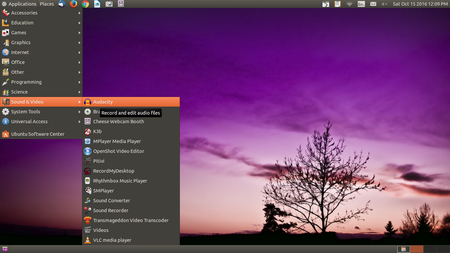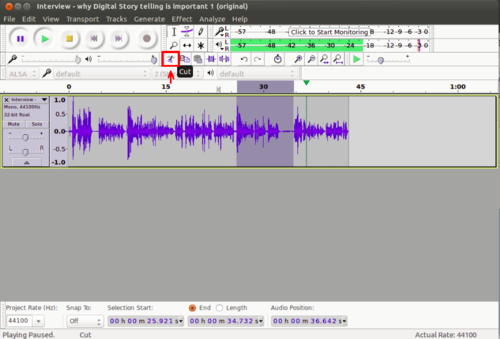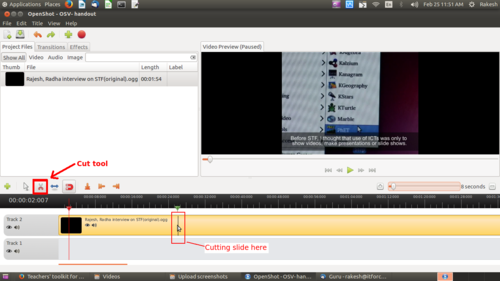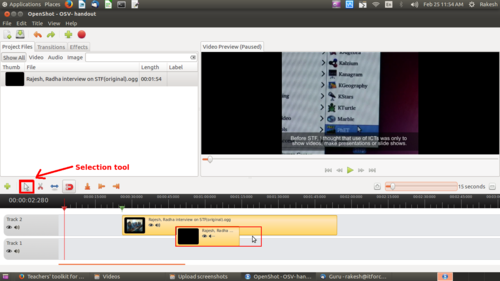Difference between revisions of "Teachers' toolkit for creating and re-purposing OER using FOSS/Audio and Video OER"
| Line 189: | Line 189: | ||
==== Adding a slide (this can be used for sub-titling as well) ==== | ==== Adding a slide (this can be used for sub-titling as well) ==== | ||
| − | + | Here, can add multiple image slides into video clips in different time frames. <br> | |
Image - Adding image slide into video track <br> | Image - Adding image slide into video track <br> | ||
[[File:3. Inserting slides into video .png|500px]] <br> | [[File:3. Inserting slides into video .png|500px]] <br> | ||
Subtitling existing videos | Subtitling existing videos | ||
| − | Sub-titles | + | Sub-titles or provide your native language text as sub-titles |
====Adding fade in and fade ==== | ====Adding fade in and fade ==== | ||
Revision as of 13:53, 25 February 2017
In this chapter of the tool-kit, you will learn how to create and re-purpose audio and video OER. You will learn
- about popular repositories for accessing audio and video OER.
- how to create audio resources using your audio recorder (with your mobile phone)
- how to edit audio resources using audio editor (Audacity)
- how to create video resources using your video recorder (mobile phone)
- how to create simple video resource using a screen-casting tool (RecordMyDesktop)
- how to edit video resources using video editor (OpenShot).
- how to embed / insert links to audio and video resources in a text document (LibreOffice Writer)
Inserting links to audio and video resources in a ‘slide presentation’ (LibreOffice Impress)
Accessing audio OER repositories
Freesound (https://freesound.org) is an audio OER repository. You can search for sounds in this repository.
- http://Soundcloud.com is also an audio repository. You will need to check the copyright of the audio you want to re-use.
- You can use a search engine such as Google search engine or DuckDuckGo search engine, using a FOSS web browser such as Mozilla Firefox.
When you visit the site or check a specific resource, you need to look for copyright information to ascertain that the resource is OER and you can re-use it. If the resource is not explicitly declared to be an OER (allowing you to re-use), you should not use it in making your OER.
This can be made easier by providing OER as a criteria in your search itself. In Google search you need to select Settings → Advanced Search. In Advanced Search, you can select Usage Rights as ‘free to use, share or modify, even commercially’ to get OER that you can re-use with or without modification.
Accessing video OER repositories
- http://Youtube.com is a popular repository for videos, it contains both OER and non OER videos. It is the largest collection of videos in the world.
You can enter your topic name in the search bar in Youtube to search for videos on that topic. To get videos which you can re-use, you need to click on the ‘Filter’ link on the Youtube page and select ‘Creative Commons’, with this step you will see videos that have the CC license (are OER).
Image showing selection of CC videos in Youtube
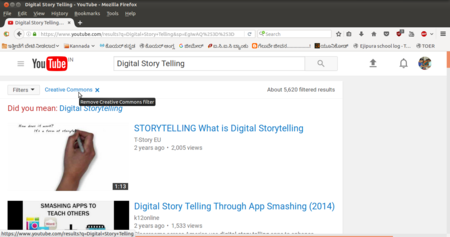
You can click on the video, this will open the video and it will begin playing. You can download the video by clicking on the download link below the video. You can download in different formats
Image showing downloading of videos in Youtube
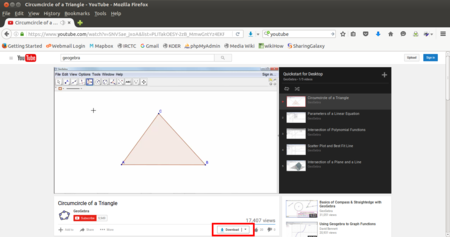
- There are other OER video sources too, you can visit, such as Vimeo , https://en.wikipedia.org/wiki/List_of_educational_video_websites, http://libguides.tcc.edu/c.php?g=304199&p=2028121 etc. A google search on ‘OER Videos’ will also give you a list of sites to explore.
Creating image audio resources using your audio recorder (on your mobile phone)
You can record an audio clip using your mobile phone itself, using any audio recording app, such as ‘recorder’. You can copy the audio file from your phone to your computer for editing and re-mixing to create OER. While recording, make sure that no copyright music or sound is playing in the background.
We have recorded a short interview with a teacher on why Digital Storytelling is important, using a mobile phone and copied the clip to our computer as ‘Interview - why Digital Storytelling..’
Edit audio resources using audio editor (using Audacity)
You can use Audacity to edit your audio clips. Audacity is a simple yet powerful application for audio editing. You can also use it to record audio.
Open Audacity on your computer, through Applications → Sound and Video → Audacity
We will need to ‘import’ the audio we have (of the teacher interview) into Audacity
Create a new track, choose Track → Add new → Stereo track
Import your audio into Audacity through File → Open and select your audio file
Image importing audio file into Audacity
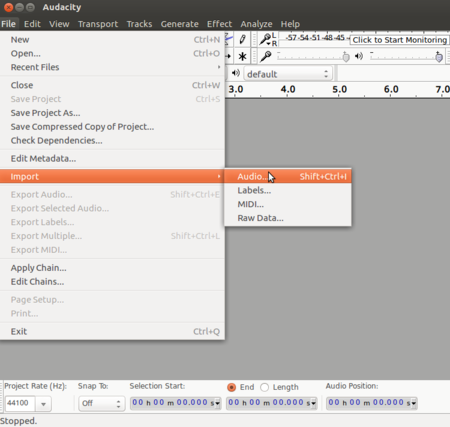
You should also import your audio clip which you want to edit. You can add tracks to the audacity file.
This software is very powerful with many sophisticated features (for advanced features, refer to the user manual on http://manual.audacityteam.org/ and tutorials on http://manual.audacityteam.org/man/tutorials.html) . However, we will learn a few commonly used functions, in audio editing, which are useful to teachers in creating and re-purposing OER:
- Moving a selection of audio
- Adding a background music track
- Reducing background noise levels
Moving a selection of audio
Just like you can cut (or copy) paste a selection of text in a text document, you can cut (copy) and paste a selection of audio in an audio file. You can use this function to remove any part of the audio clip you do not want. You can move a part of a clip from one place to another (for instance if you want to re-order responses in an interview). You can also delete a part of the clip also using the same functionality.
Original Audio file
Edited audio file
Adding a background music track
You may want to add background music to an audio recording. It is easy to do this with Audacity. We can add as many tracks as we want, with one audio file per track.
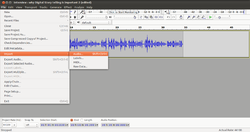
Adding a track in Audacity for background music |
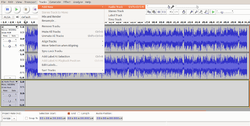
Audacity_4_Add_New_track |
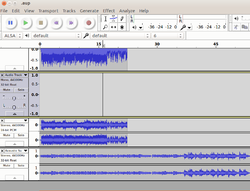
Audacity_5_Multipal_Track |
Amplifying sound
You may have an audio recording where there is some unwanted disturbance throughout, such as traffic sounds. You can use the ‘Noise Reduction’ function in Audacity to reduce the background noise. You can also use the ‘amplify’ function to increase or reduce the sound level in a track.
Select the track, Goto "Effect from the menu bar, select amplify and reduce the track pitch.
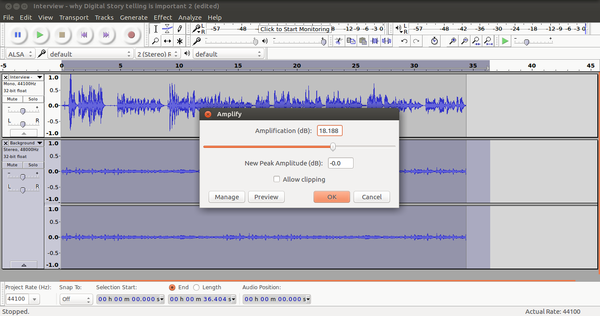
Exporting the Audacity project to create audio output file
After completing your editing tasks, select File → Export and select the file format as MP3 and click export, to create an output audio file in .mp3 format.
You can also save the Audacity project to continue editing, for this select File → Save.
Image exporting Audacity project to create audio output file
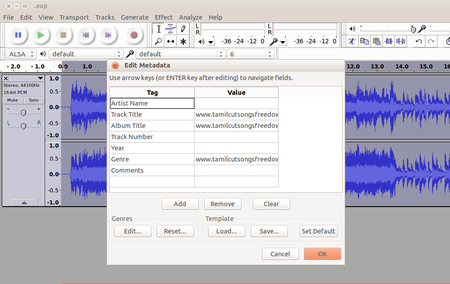
Audacity is particularly useful for a language teacher to create audio resources for language learning.
Creating video resources using your video recorder (on your mobile phone)
You can record a video clip using your mobile phone itself, using the camera on the phone. While recording the video, take care to ensure that you are not shooting copyright materials or private spaces. You can copy the video file from your phone to your computer for editing and re-mixing to create OER.
Creating a video resource using a screen-casting tool (RecordMyDesktop)
Screen casting is also a very simple yet powerful way of creating a video resource. The recordmydesktop software records the computer output display as the video and audio. Additional audio spoken or played during the recording is also recorded as a part of the video.
Applications → Sound & Video → RecordMyDesktop
*** Image to show opening RecordMyDesktop
https://teacher-network.in/OER/images/7/7b/RecordMyDesktop_1_Main_Window.png
You can use recordmydesktop to create videos OER. Make sure you are not displaying copyright material on the screen when recording the video. If you record any copyright material in the video, it will be a copyright violation.
Configuring recordmydesktop
The better the quality of video and audio, the bigger will be the size of recorded file. You can adjust video and audio quality (and consequently size of the output video file) by adjusting the slider near the top right of this window. (Tip - Video Quality of 50% is good enough for most purposes and will keep file size lower).
Image - COL - Adjusting Video quality in recordmydesktop.png
Recording part of the screen
Select window: You can also select the window to record, click on select window, then it will ask you to grab the area to select. You can select only that part of the screen that you want to record. This is useful if you are opening photos or playing a video on only part of your screen and want to record that part only.
Image - COL - Recordmydesktop select area to record.png
Recording
When you click on RECORD button, desktop recording will start
*** Image to show recording video using RecordMyDesktop
https://teacher-network.in/OER/images/b/b1/RecordMyDesktop_6_Red_Button.png
The recording can be paused and resumed at any time, by right clicking on the RecordMyDesktop icon in the top panel and selecting Pause (and Resume). Clicking on ‘Stop’ will stop the recording and initiate the export of the video output.
We need to wait till the export is completed, to get the output file. If we close the process before, we will lose the output file. The output file will be saved in your "HOME" folder by default with .OGV format. The file will usually have a name like ‘out.ogv’, however you can use the ‘save as’ button on the recordmydesktop screen to give a file name.
*** Image to show exporting output file RecordMyDesktop
https://teacher-network.in/OER/images/6/6f/RecordMyDesktop_7_Encoder.jpg
As a teacher, one of the ways you can make resources is to use recordmydesktop to create a video file by combining your voice narration with a set of slides or pictures or a video (or a combination of these) on your screen. You can simply play a slideshow of your slide presentations or images in your folder, or a video, recording these through recordmydeskop and providing the audio with your explanation / lecture. This can be used to create lessons for reinforcing learning or for students who have missed a class, to catch up.
Dubbing a video
You can use this tool to provide voice dubbing for a video. For instance, you may find many OER videos in American English and you may want to change the language of narration to your own native language, to make the video more useful to your students.
You should to prepare the script for your narration in the language you want to dub the video in.
You need to set the sound settings on your computer to ‘mute’ (no output). Then start recordmydesktop application and play the video. As the video plays, read out your script. The audio read out by you will be combined with the video being shown on the screen to create the video in your language.
We have taken a video of a teacher speaking in Kannada about a program he has been a part of, and dubbed it in English.
** Video – Original video in Kannada and dubbed video in English
You could try this with any OER video you like, which is in accented English spoken in the USA or UK and dub it with your own voice, in English or your native language.
Editing video resources using video editor (OpenShot).
You can use OpenShot video editor to edit your video clips. OpenShot is a simple yet powerful application for video editing.
Open OpenShot on your computer, through Applications → Sound and Video → OpenShot
Image - COL - Video editing using Openshot
We will need to ‘import’ the video we have into OpenShot. You can also import photos and audio files and combine images, audio and video files to create a video output.
Import your video into OpenShot through File → Open and select your video file
** Image https://teacher-network.in/OER/images/thumb/7/7a/Openshot_1_Main_Window.png/450px-Openshot_1_Main_Window.png
You should also import your video clip which you want to edit. You can add tracks to the OpenShot project.
This software is very powerful with many sophisticated features (for advanced features, refer to the user manual and tutorials, provided in Annexure) . However, we will learn a few commonly used functions, in video editing, which are useful to teachers in creating and re-purposing OER:
- Moving a selection of video
- Adding a slide (this can be used for sub-titling as well)
- Adding fade in and fade
- Adding a transition
Moving (cut and paste of) a selection of video
Just like you can cut, paste a selection of text in a text document, you can cut and paste a part of the video by using drag and drop option of the video file. You can use this function to remove any part of the video clip you do not want. You can move a part of a clip from one place to another (for instance if you want to re-order responses in an interview). You can also delete a part of the clip also using delete key from the keyboard(or right click and remove clip).
| Image – Cutting video clip by using cut tool |
Image – Moving a video clip by dragging and draping |
|---|
Adding a slide (this can be used for sub-titling as well)
Here, can add multiple image slides into video clips in different time frames.
Image - Adding image slide into video track

Subtitling existing videos Sub-titles or provide your native language text as sub-titles
Adding fade in and fade
By adding fade-in and fade-out for the clips, it will smoothly changing the slides from one to next.
Just right click on slide and fade -> select fade in or fade out as per the requirement. This fade will effect for both audio and video.
Image - Adding fade in, fade out for slides and for video clips.
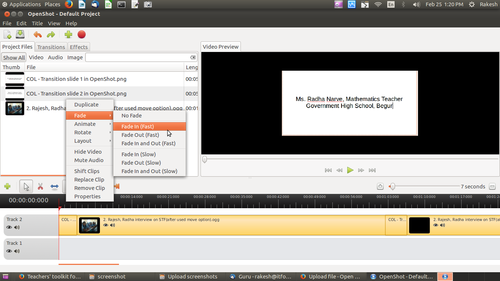
Adding a transition
In openshot video editors have some default transactions in the transaction tab, select a transaction and drag-drop it on the video.
Image - Adding transaction(different effects) into the track.
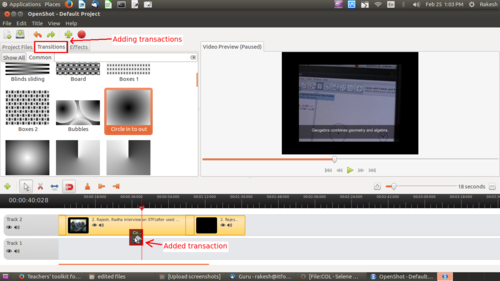
Inserting links to audio and video resources in a text document (LibreOffice Writer)
Inserting links in a ‘slide presentation’ format (LibreOffice Impress)
Alternative applications - audio
Ocenaudio and Wavosaur are alternative FOSS audio editors
Alternative applications - video
SimpleScreenRecorder and Kazam are alternative screen recorders on GNU/Linux
Kdenlive is a sophisticated video editing software application on GNU/Linux.
